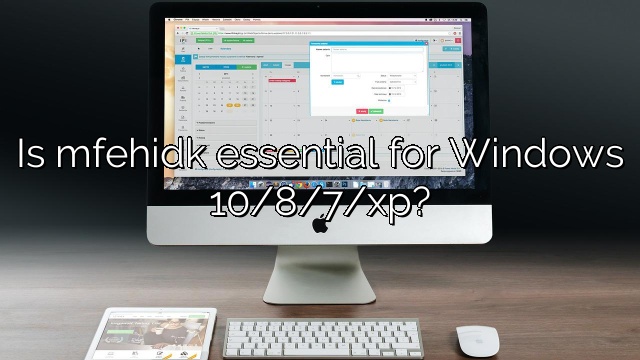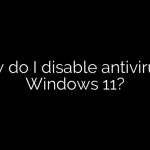
Is mfehidk essential for Windows 10/8/7/xp?
Damaged or faulty hardware: Some of mfehidk. sys stop error messages are caused by corrupted or faulty temporary memory (RAM). Mfehidk. sys blue screen of death is also sometimes the result of a damaged hard drive.
Description: McAfee Link Driver File Extension: SYS file extension File Name: mfehidk.sys Object File Type: Driver
How do I fix Mfehidk in Windows 10?
Open System Configuration.
Select the Services tab.
Uncheck all McAfee support to disable it.
Click the Home tab.
Uncheck all synonyms associated with McAfee to disable them.
Click Apply, then click OK.
Click Restart when prompted to restart your computer.
What does Mfehidk sys mean?
Mfehidk. sys is any system process that runs in the background of your computer and contains your intrusion detection system for McAfee Antivirus. Mfehidk. sys works like most antivirus software and uses a lot of CPU memory.
What is mfeaack sys?
Mfek. is considered an important file type for the McAfee Arbitrary Access Control driver. It is most often created in SYSCORE, developed by McAfee, Inc. It uses the SYS file format and is considered a Win64 EXE (driver) file. First version under mfeaack.
What is mfehidk SYS?
Specifically, Mfehidk.sys uses the SYS file extension, which is more specifically known as the McAfee Link Driver file. It is considered a Win64 EXE document (driver) created for syscore McAfee, Inc. McAfee Total Protection 2019 (16.0 R20) for Windows 10 released on August 29, 2019 introduced mfehidk.sys.
How to fix mfehidk driver not working in Windows 10?
After booting from the CD, select the recovery options and go to the command prompt. Then enter the command relabel d:\windows\system32\drivers\mfehidk.sys mfehidk.bak at the command prompt and exit.
Is mfehidk essential for Windows 10/8/7/xp?
mfehidk.sys should not be needed for Windows 10/8/7/XP and will often cause problems. Click below to find out what mfehidk provides and how to remove mfehidk.sys. Microsoft Partner file.net Deutsch What is mfehidk really? The real mfehidk.sys file is a wonderful software component of SYSCORE by McAfee LLC.
What driver is Mfehidk sys?
Mfehidk. sys uses the SYS file extension, which is more likely to be recognized as a McAfee Link Driver file. This is classified as a simple creation of a Win64 EXE (driver file) created by SYSCORE from McAfee, Inc.
What failed mfehidk sys?
Damaged or faulty hardware: from some mfehidk. sys stop error Sell messages are caused by corrupted or faulty temporary memory (RAM). Mfehidk. sys blue screen of death is also sometimes the result of an old hard drive.
What does Mfehidk sys do?
Mfehidk. sys is a system process that runs in the background of your computer and also performs system intrusion diagnostics for McAfee Antivirus. Mfehidk. sys works similarly to antivirus programs and consumes more CPU memory.
How to join SYS databases, sys.tables and sys columns?
The column does not exist in most tables, so some generated code should not contain query tables that are still active without this column. To solve this problem, I actually found a way to log in from sys.databases with sys.tables and then with sys.columns. Or an alternative to query all required databases in a cost-saving way.
How do I fix Mfehidk?
Solution 2 – Rename mfehidk Follow these steps to remove mfehidk. sys by renaming the statement on the command line and then download the latest version from the mcafee software. Insert the product repair disc into your computer’s CD/DVD hard drive and turn off your computer. Turn on the personal computer.
How do I disable Mfehidk?
Disable and McAfee
- Open the updated system configuration. …
- Go to the My Services tab.
- Uncheck all McAfee services to disable them. …
- Go to the Home tab.
- Uncheck all McAfee-related synonyms to disable them….
- Click Apply , then Restart,
- click if prompted to restart your computer.
How do I get rid of pagefile sys and Hiberfil sys Windows 10?
How to remove Hiberfil. Windows 10 system
- Open File Explorer, then click the View button in the top menu.
- Then select Options starting from the View tab in the new window.
- Select “Show”. hidden files, folders, and entries.
- Uncheck Hide protected files with operating system information (recommended). …
- Now select Apply.

Charles Howell is a freelance writer and editor. He has been writing about consumer electronics, how-to guides, and the latest news in the tech world for over 10 years. His work has been featured on a variety of websites, including techcrunch.com, where he is a contributor. When he’s not writing or spending time with his family, he enjoys playing tennis and exploring new restaurants in the area.










